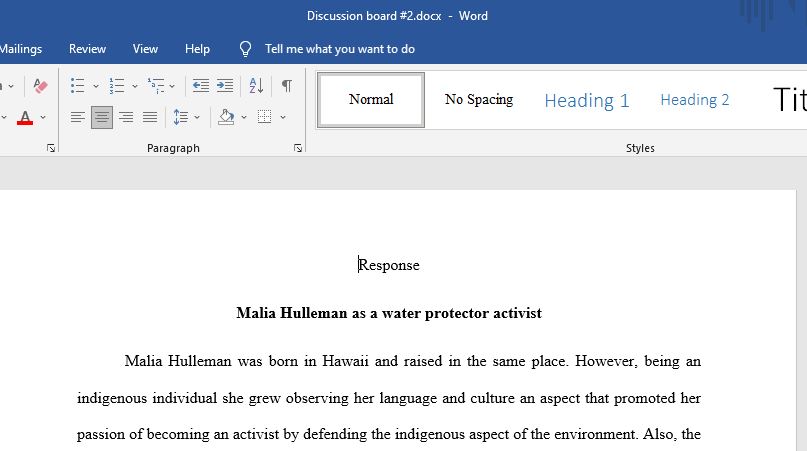Discussion board Malia Hulleman as a water protector activist
Toward the middle of the week, after you have had a chance to read 1. Youth to Power Chapter 8 – Peaceful Direct Action; 2. Challenge Everything Part 4 (pages 105-144) – Challenge Yourself; and 3. Guidelines on creating brochures here and here, ideally by midnight Friday but no later than midnight Saturday, post a response to at least oneof the following questions. Try to choose a question that no classmate has answered yet. If this is not possible, try to add a perspective that has not yet been discussed.
Questions on 1. Youth to Power Chapter 8
1. Why does Margolin say that it is sometimes necessary to disobey a law, and what does this have to do with democracy? Do you agree with Margolin on this?
2. What did Martin Luther King Jr. mean by the term “negative peace,” what does this concept have to do with civil disobedience, and why does Margolin say, “There still exists a negative peace in our society” (97)? Do you agree?
3. Choose one of the examples of civil disobediencethat Margolin discusses on pages 98-99; briefly sum it up in your own words; explain whether you consider it to be an example of a protest or a direct action, as we have defined these terms in the Week 5 Discussion; discuss why Margolin considers a success; and reflect on whether you would consider it a good model for an action that you might like to be involved with.
4. Choose one of the seven recommendations that Margolin makes in pages 100-104, describe it in your own words, identify any questions or concerns that you might have about it, and discuss how you might follow this advice if you were going to engage in an act of civil disobedience.
5. Sum up in your own words the story of activist water protector Malia Hulleman and her experiences with the Standing Rock #NODAPL movement. Can you imagine joining such a movement, for example the Stop Line 3actions in Minnesota.
Questions on Challenge Everything Part 4 (pages 105-144) – Challenge Yourself
6. Tell us in your own words the main points that Sandford makes in her introduction to this section, pages 107-108.
7. This section has a somewhat looser organization than the sections on Big Business and Government. Sandford offers nine ideas–Self-Sufficiency, Question Everything, Decide Your Own Morals, Your Opinions Are Valid, Reclaim/Rewild/Reconnect, Scavenging, How to Eat, Community, and Art–that generally move from inside the individual out to the community and beyond. Choose one or more of these sections, explain in your own words what Sandford says about it, and reflect on how this idea might be relevant to you as an activist, a citizen, a student, or just a person.
8. Like the sections on Big Business and Government, this section ends with a series of questions for the reader. If you have answered these questions and don’t mind sharing your answers, please post them here!
Questions on Guidelines for Creating Brochures here and here.
9. Choose one or more of the guidelines/tips offered by Academic Help for writing brochures–look particularly at the sections on Key Points, Do’s and Don’ts, and Common Mistakes–explain it, and discuss how it might help us create our Green Dorm Brochure.
10. Choose one or more of the guidelines/tips offered by The University of Nebraska for writing brochures–look particularly at the Getting Startedsection, the analysis of a sample brochure, and section on Brochure Rack Test–explain it, and discuss how it might help us create our Green Dorm Brochure.
Requirements: 1 page
Answer preview:

word limit:457
